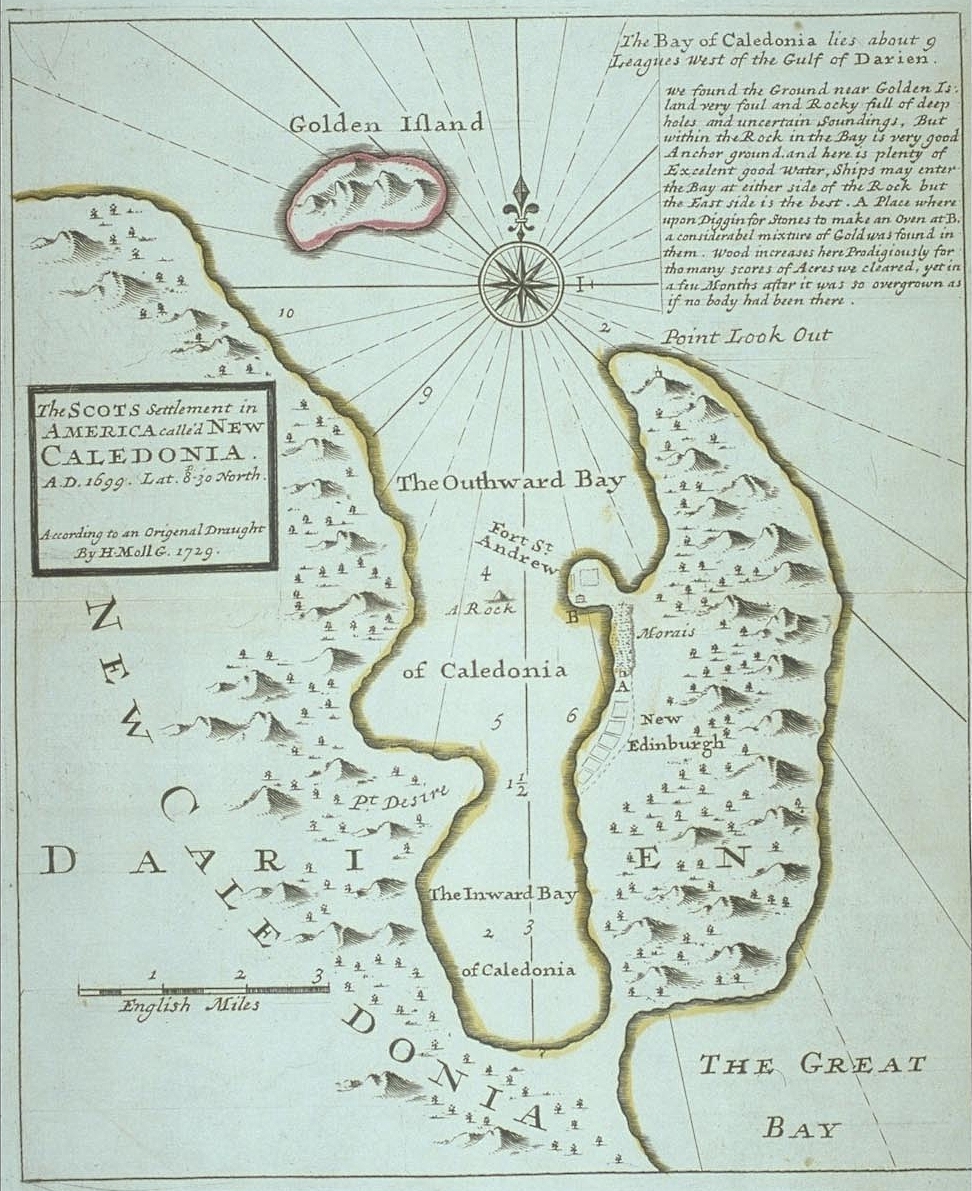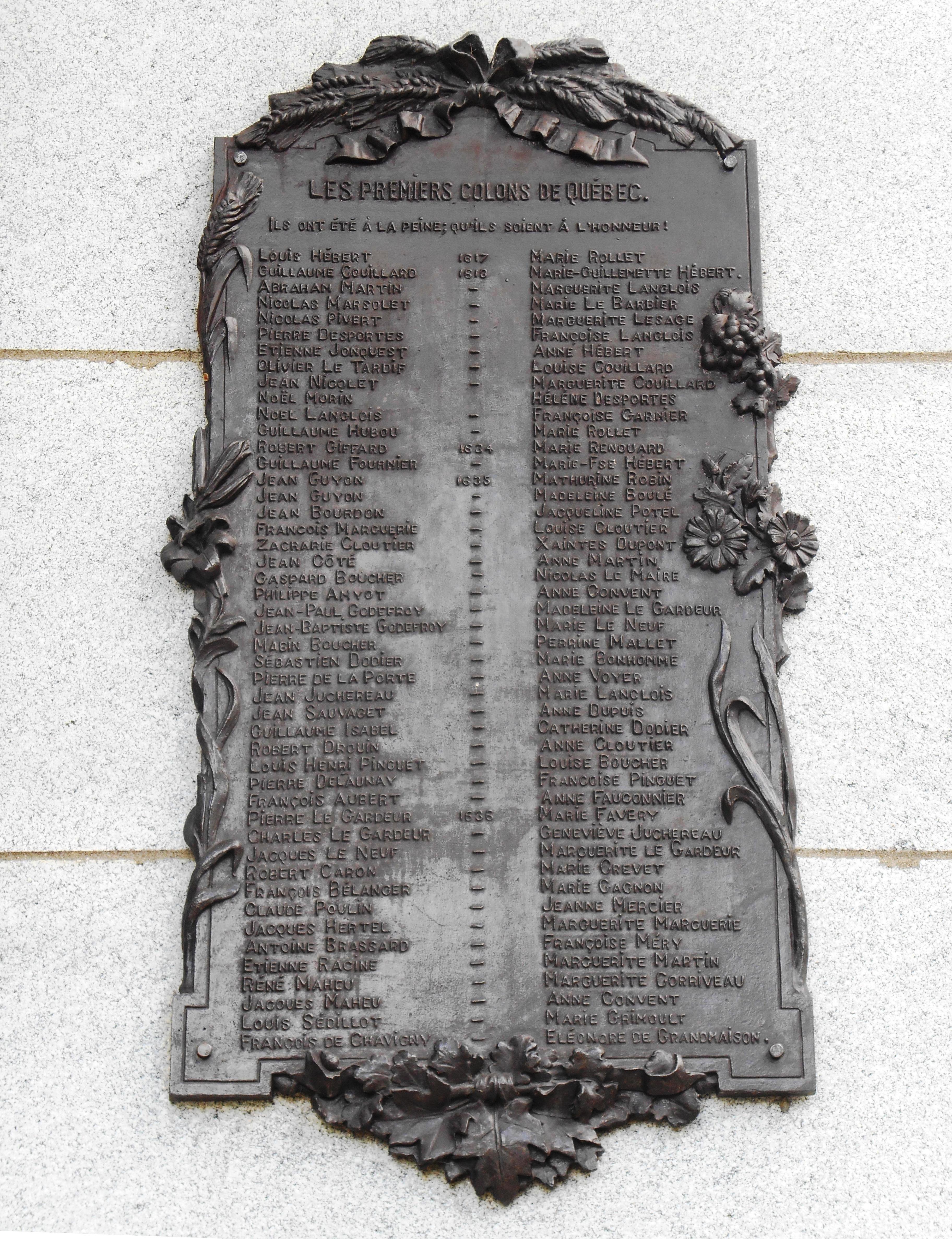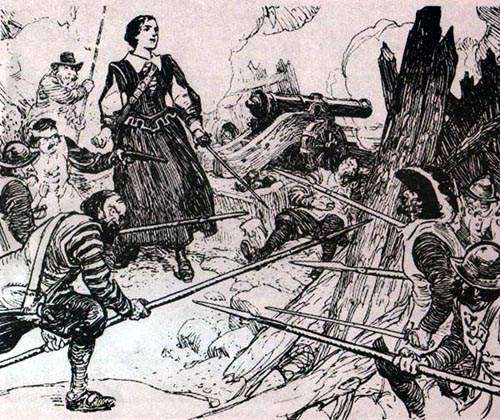|
Scottish Colonization Of The Americas
The Scottish colonization of the Americas comprised a number of Scottish colonial settlements in the Americas during the early modern period. These included the colony of Nova Scotia in 1629, East Jersey in 1683, Stuarts Town, Carolina in 1684 and New Caledonia in 1698. Nova Scotia (1621) The first documented Scottish settlement in the Americas was of Nova Scotia in 1629. On 29 September 1621, the charter for the foundation of a colony was granted by James VI of Scotland to Sir William Alexander. Between 1622 and 1628, Sir William launched four attempts to send colonists to Nova Scotia; all failed for various reasons. A successful settlement of Nova Scotia was finally achieved in 1629. The colony's charter, in law, made Nova Scotia (defined as all land between Newfoundland and New England; i.e., The Maritimes) a part of mainland Scotland; this was later used to get around the English navigation acts. Due to difficulties in obtaining a sufficient number of skilled emigrants, ... [...More Info...] [...Related Items...] OR: [Wikipedia] [Google] [Baidu] |
Kingdom Of Scotland
The Kingdom of Scotland was a sovereign state in northwest Europe, traditionally said to have been founded in 843. Its territories expanded and shrank, but it came to occupy the northern third of the island of Great Britain, sharing a Anglo-Scottish border, land border to the south with the Kingdom of England. During the Middle Ages, Scotland engaged in intermittent conflict with England, most prominently the Wars of Scottish Independence, which saw the Scots assert their independence from the English. Following the annexation of the Hebrides and the Northern Isles from Norway in 1266 and 1472 respectively, and the capture of Berwick upon Tweed, Berwick by England in 1482, the territory of the Kingdom of Scotland corresponded to that of modern-day Scotland, bounded by the North Sea to the east, the Atlantic Ocean to the north and west, and the North Channel (British Isles), North Channel and Irish Sea to the southwest. In 1603, James VI of Scotland became King of England, joini ... [...More Info...] [...Related Items...] OR: [Wikipedia] [Google] [Baidu] |
Quebec City
Quebec City is the capital city of the Provinces and territories of Canada, Canadian province of Quebec. As of July 2021, the city had a population of 549,459, and the Census Metropolitan Area (including surrounding communities) had a population of 839,311. It is the twelfthList of the largest municipalities in Canada by population, -largest city and the seventh-List of census metropolitan areas and agglomerations in Canada, largest metropolitan area in Canada. It is also the List of towns in Quebec, second-largest city in the province, after Montreal. It has a humid continental climate with warm summers coupled with cold and snowy winters. Explorer Samuel de Champlain founded a French settlement here in 1608, and adopted the Algonquin name. Quebec City is one of the List of North American cities by year of foundation, oldest European settlements in North America. The Ramparts of Quebec City, ramparts surrounding Old Quebec () are the only fortified city walls remaining in the ... [...More Info...] [...Related Items...] OR: [Wikipedia] [Google] [Baidu] |
Cape Sable Island
Cape Sable Island, locally referred to as Cape Island, is a small Canada, Canadian island at the southernmost point of the Nova Scotia peninsula. It is sometimes confused with Sable Island. Historically, the Argyle, Nova Scotia region was known as Cape Sable and encompassed a much larger area than simply the island it does today. It extended from Cape Negro, Nova Scotia, Cape Negro through Chebogue, Nova Scotia, Chebogue. The island is situated in Shelburne County south of Barrington Head, Nova Scotia, Barrington Head, separated from the mainland by the narrow strait of Barrington Passage, but has been connected since 1949 by a causeway. The largest community on the island is the town of Clark's Harbour. Other communities are listed below. At the extreme southern tip is Cape Sable. History Cape Sable was first inhabited by the Mi'kmaq, who called the area and generally the island itself "Kespoogwitik", meaning "where the land ends". Cape Sable Island was charted by explorers f ... [...More Info...] [...Related Items...] OR: [Wikipedia] [Google] [Baidu] |
Saint John, New Brunswick
Saint John () is a port#seaport, seaport city located on the Bay of Fundy in the province of New Brunswick, Canada. It is Canada's oldest Municipal corporation, incorporated city, established by royal charter on May 18, 1785, during the reign of George III. The Port of Saint John is Canada's third-largest by tonnage with a cargo base that includes dry and liquid bulk, Breakbulk cargo, break bulk, containers, and cruise. The city has a strong industrial base, including oil refining and manufacturing, matched with finance and tourism sectors and research institutions such as the New Brunswick Museum and the University of New Brunswick. Saint John was the most populous in New Brunswick until the 2016 Canadian census, 2016 census, when it was overtaken by Moncton. It is currently the second-largest city in the province, with a population of 69,895 over an area of . French explorer Samuel de Champlain landed at Saint John Harbour on June 24, 1604, the feast of St. John the Baptist, ... [...More Info...] [...Related Items...] OR: [Wikipedia] [Google] [Baidu] |
Charles De Menou D'Aulnay
Charles de Menou d'Aulnay (''de Charnisay'') (–1650) was a French pioneer of European settlement in North America and Governor of Acadia (1635–1650). D'Aulnay was a member of the French nobility who was at various times a sea captain, a lieutenant in the French navy (under leadership of his cousin Isaac de Razilly), and Governor of Acadia (now primarily Nova Scotia and New Brunswick, Canada). Biography D'Aulnay was born at Château de Charnizay, Touraine, France. His father was a high-ranking official for Louis XIII. He came to serve as assistant to the governors and eventually lieutenant governor of Acadia. Acadia under Razilly In 1632, Isaac de Razilly became governor of Acadia, having been selected by the government to restore to France her Acadian possessions. D'Aulnay, serving as one of the governor's able assistants, helped to borrow funds, hire ships, and recruit men for the regular ocean crossings to and from France for the Compagnie des Cent-Associés and a pri ... [...More Info...] [...Related Items...] OR: [Wikipedia] [Google] [Baidu] |
LaHave, Nova Scotia
LaHave (''La Hève'') is a Canadian community in Lunenburg County, Nova Scotia. The community is located across the river from Riverport and approximately 15 kilometres from the town of Bridgewater. Once the capital of Acadia, it is located on Highway 331 at the mouth of the 97 km long LaHave River. LaHave Islands The LaHave Islands are a small group of islands near shore a few km south of LaHave. Some of the islands are linked by a road to the mainland. The islands are a popular coastal paddling destination. The LaHave Islands Marine Museum (c. 1913), located on Bush Island and accessible by road, is on the Canadian Register of Historic Places. Nearby is Bush Island Provincial Park. History Mi'kmaq Settlement and French colony La Hève was an important centre for the Mi'kmaq people, who traded with Europeans. Messamouet, a well-known ''sakmow'', or Chief, of the Mi'kmaq Nation, is reported to have been from the LaHave area. Samuel de Champlain called there in ... [...More Info...] [...Related Items...] OR: [Wikipedia] [Google] [Baidu] |
Isaac De Razilly
Isaac de Razilly (1587–1635) was a member of the French nobility appointed a knight of the Order of St. John of Jerusalem at the age of 18. He was born at the Château d'Oiseaumelle in the Province of Touraine, France. A member of the French navy, he served for many years during which he played an important role in the French colony of Acadia in New France. He was the son of François de Razilly and Catherine de Villiers, brother of Claude de Razilly and François de Razilly. Brazil Isaac de Razily explored the coast of Brazil in 1612-15 near the island of Marajó, in the attempts to establish France Equinoxiale, with his brother and leader of the expedition François de Razilly. Morocco (1619–1624) Issac de Razilly already sailed to Morocco in 1619, under the orders of Louis XIII who was considering a colonial venture in Morocco. He was able to reconnoiter the coast as far as Mogador. In 1624, he was put in charge of an embassy to the pirate harbour of Salé in Mo ... [...More Info...] [...Related Items...] OR: [Wikipedia] [Google] [Baidu] |
Treaty Of Saint-Germain-en-Laye (1632)
The Treaty of Saint-Germain-en-Laye was signed on March 29, 1632. It returned New France (Quebec, Acadia and Cape Breton Island) to French control after the English had seized it in 1629,"KIRKE, SIR DAVID, adventurer, trader, colonizer, leader of the expedition that captured Quebec in 1629, and later governor of Newfoundland" ''Dictionary of Canadian Biography Online'' after the Anglo-French War (1627–1629) had ended. On 19 July 1629, an English fleet under the command of David Kirke managed to cause the surrender of Quebec by intercepting its supplies, which effectively reduced Samuel de Champlain and his men to starvation.David Dobson, 'Seventeenth Centu ... [...More Info...] [...Related Items...] OR: [Wikipedia] [Google] [Baidu] |
Treaty Of Suza
The Treaty of Susa (also sometimes spelled Suza) refers to two separate peace treaties signed in 1629 at Susa in the Duchy of Savoy (now in the Italian Piedmont, near the French border), recently occupied by France during the Thirty Years' War. Treaty between France and Savoy This treaty, signed on 11 March 1629, after the French capture of the city, was agreed between Louis XIII of France and Charles Emmanuel I, Duke of Savoy. Its terms allowed French military passage through Savoy to assist in relief of the siege of Casale in the War of the Mantuan Succession, which was to be guaranteed by French occupation of Susa. The Duke was also to refrain from hostilities against the Duchy of Mantua. In return, France was to give Savoy Trino and other territory in Monferrat worth 15,000 crowns. Treaty between France and England and Scotland This treaty, signed on 14 April 1629 ended a war between England and France that had broken out in 1627. Ratified by Charles I of England ... [...More Info...] [...Related Items...] OR: [Wikipedia] [Google] [Baidu] |
Charles I Of England
Charles I (19 November 1600 – 30 January 1649) was King of Kingdom of England, England, Kingdom of Scotland, Scotland, and Kingdom of Ireland, Ireland from 27 March 1625 until Execution of Charles I, his execution in 1649. Charles was born into the House of Stuart as the second son of King James VI of Scotland, but after his father inherited the English throne in 1603, he moved to England, where he spent much of the rest of his life. He became heir apparent to the kingdoms of England, Scotland, and Ireland in 1612 upon the death of his elder brother, Henry Frederick, Prince of Wales. An unsuccessful and unpopular attempt to marry him to Infanta Maria Anna of Spain culminated in an eight-month visit to Habsburg Spain, Spain in 1623 that demonstrated the futility of the marriage negotiation. Two years later, shortly after his accession, he married Henrietta Maria of France. After his accession in 1625, Charles quarrelled with the English Parliament, which sought to curb his ro ... [...More Info...] [...Related Items...] OR: [Wikipedia] [Google] [Baidu] |
Cape Sable Island, Nova Scotia
Cape Sable Island, locally referred to as Cape Island, is a small Canadian island at the southernmost point of the Nova Scotia peninsula. It is sometimes confused with Sable Island. Historically, the Argyle, Nova Scotia region was known as Cape Sable and encompassed a much larger area than simply the island it does today. It extended from Cape Negro through Chebogue. The island is situated in Shelburne County south of Barrington Head, separated from the mainland by the narrow strait of Barrington Passage, but has been connected since 1949 by a causeway. The largest community on the island is the town of Clark's Harbour. Other communities are listed below. At the extreme southern tip is Cape Sable. History Cape Sable was first inhabited by the Mi'kmaq, who called the area and generally the island itself "Kespoogwitik", meaning "where the land ends". Cape Sable Island was charted by explorers from Portugal who named it "Beusablom", meaning "Sandy Bay". French Colony Cape Sab ... [...More Info...] [...Related Items...] OR: [Wikipedia] [Google] [Baidu] |
Port-Royal (Acadia)
Port Royal (1605–1713) was a historic settlement based around the upper Annapolis Basin in Nova Scotia, Canada, and the predecessor of the modern town of Annapolis Royal. It was the first successful attempt by Europeans to establish a permanent settlement in what is today known as Canada. Port Royal was a key step in the development of New France and was the first permanent base of operations of the explorer Samuel de Champlain, who would later found Quebec City, Quebec in 1608, and the farmer Louis Hébert, who would resettle at Quebec in 1617. For most of its existence, it was the capital of the New France colony of Acadia. Over 108 years control would pass between France, Scotland, England and Great Britain until it was formally ceded to Great Britain in 1713 due to the Treaty of Utrecht. From 1605 to 1613 the settlement was centred around the habitation on the north side of the Annapolis Basin, while from 1629 onwards it was centred around Fort Anne on the south side, ... [...More Info...] [...Related Items...] OR: [Wikipedia] [Google] [Baidu] |






